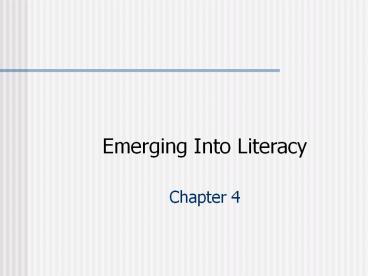Emerging Into Literacy PowerPoint PPT Presentation
1 / 18
Title: Emerging Into Literacy
1
- Emerging Into Literacy
- Chapter 4
2
Emerging Into Literacy
- Overview
- Objectives
- Key Terms
3
Fostering Young Childrens Interest In Literacy
- Concepts About Written Language
- Purpose and Opportunities pp. 162-163
- Concept of a Word
- Environmental Print
- Literacy Play Centers
4
Fostering Young Childrens Interest In Literacy
- Concepts About the Alphabet
- The Alphabetic Principle
- Letter Names
- Routines to Teach Alphabet p. 168
- Phonemic Awareness
- Manipulate spoken language p. 169
- 5 types of activities p. 171
5
Fostering Young Childrens Interest In Literacy
- Concepts About the Alphabet, contd.
- Phonics
- Consonants
- Vowels
- Rimes and Rhymes
- Phonics Generalizations
6
Young Children Emerge Into Reading
- Shared Reading
- Step by Step p. 179
- Predictable Books
- Repetition, Cumulative Sequence, Rhyme and
Rhythm, Sequential Patterns - Big Books
- Cross-Age Reading Buddies
- Traveling Bags of Books
7
Young Children Emerge Into Reading
- Language Experience Approach
- Step by Step p. 187
8
1. Provide an experience.
- Experience must be meaningful in which all
participated - school experience
- book read aloud
- field trip
9
2. Talk about the experience.
- Students teacher discuss experience
- to generate words/vocabulary
- to review the experience
- to extend their understanding
- Ask open-ended questions.
10
3. Record the dictation.
- Teacher writes down childs dictation
- for individuals in booklets or on sheets of
paper. - for groups on chart paper or using word
processor.
11
3. Record the dictation (cont.).
- About teachers writing
- Write neatly using schools style.
- Preserve as much student language as possible.
- Keep editing of word choice grammar to a
minimum.
12
3. Record the dictation (cont.).
- For individuals
- Take dictation until child finishes or hesitates.
- When child hesitates, reread what has been
written encourage child to continue.
13
3. Record the dictation (cont.).
- For groups
- Children take turns dictating sentences.
- After writing each sentence, teacher rereads it.
14
4. Read the text.
- Teacher models reading correct intonation by
reading text aloud, pointing to each word. - Children read the text together.
15
4. Read the text (cont.).
- Individuals may take turns reading.
- Text may be copied distributed to children.
16
5. Extend language abilities.
- Language abilities may be reinforced through
teacher-directed activities related to the
dictation - phoneme-grapheme correspondence
- punctuation sentence markers
17
5. Extend language abilities (cont.).
- capitalization sentences, proper nouns
- words/vocabulary
18
Young Children Emerge Into Writing
- Introducing Young Children to Writing
- Interactive Writing
- Step by Step p. 192
- Minilessons About Reading and Writing

